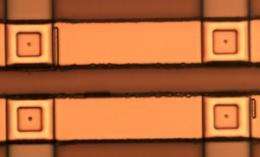Germanium-tellurium alloy could form basis for reconfigurable electronic switches

Decades of optimization have made the electronic switch both tiny and efficient. Yet engineers continue to adapt it to meet the increasingly demanding requirements of new applications. One such emerging requirement is the need for a switch to dissipate no power when it is off -- a condition that many existing compact switch designs cannot satisfy. Eng Keong Chua and co-workers at the A*STAR Data Storage Institute, Carnegie Mellon University and the Singapore University of Technology and Design have now designed a switch that draws power only during the act of switching.
The researchers focused on a group of chalcogenide materials with an atomic structure that changes from amorphous to crystalline in response to an applied voltage. The atomically disordered amorphous state is highly resistive, whereas the ordered crystalline state is highly conductive. This change in resistivity can be exploited as the basis for switch-like behavior, and as both states are energetically stable, the on or off state can be maintained without needing to continuously apply a voltage. Such ‘phase-change’ switches have been studied for some time. To date, however, the ratio of the resistances in the on and off states of phase-change switches has been too low for important classes of applications like radiofrequency electronics.
Chua and his co-workers addressed this issue by building electrical phase-change switches using a binary alloy of germanium and tellurium (GeTe), which had previously been used in phase-change memory. By carefully adjusting fabrication parameters including temperature, heating rate, gaseous flow rate, sputtering power and annealing time, they were able to fashion a thin film with a resistivity in the amorphous state over ten million times that in the crystalline state. After constructing the switch (pictured) by the attachment of copper electrodes, which are needed in order to interface the device with external electronics, this resistance ratio was 1.6 million—orders of magnitude greater than previous phase-change switches of this kind and sufficient for radiofrequency devices.
With usage, the on/off ratio of the switch was found to deteriorate gradually, which the researchers attribute to the incomplete recrystallization of the GeTe upon repeated switching. This is an issue that Chua’s team plans to address with further device optimization. “The switches may find use in electronics that are reconfigurable on the fly, with particularly promising applications in communications electronics,” says Chua. “By making components such as inductors reconfigurable, radiofrequency circuits could operate at multiple frequencies to accommodate different wireless standards with the use of a single physical structure. This could allow such circuits to be made even smaller.”
More information: Chua, E. K. et al. Low resistance, high dynamic range reconfigurable phase change switch for radio frequency applications. Applied Physics Letters 97, 183506 (2010). dx.doi.org/10.1063/1.3508954
Abstract
A GeTe reconfigurable phase change switch for radio frequency applications is presented. Low ON state resistance (180 Ω) and large dynamic range (7×103 X) were achieved through low resistance electrode design and high current. A partial crystallization and partial reamorphization model is proposed to explain the differences between the measured and calculated device ON (set) and OFF (reset) state resistances, respectively. The dependency between ON state resistance and reset current was estimated using a first order thermal design in steady state which suggests lower reset current by choosing materials of lower melting temperature and structures with better thermal isolation.
Provided by Agency for Science, Technology and Research (A*STAR)



















